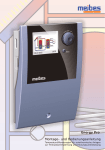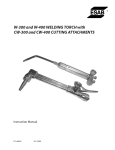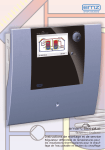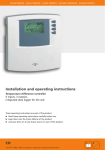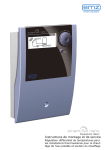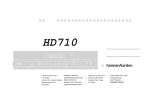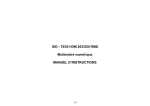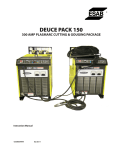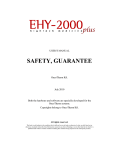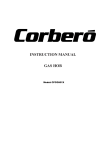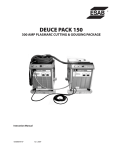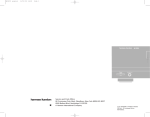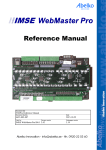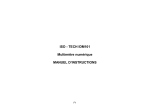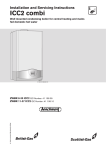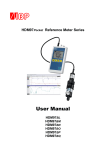Download Untitled - emz Hanauer GmbH & Co. KGaA
Transcript
These Assembly and Operating Instructions are an integral part of the product. > Read Assembly and Operating Instructions carefully before using the product. > Keep them in a safe place during the product‘s service life. Translation from the German original edition ©emz 2011 - Subject to modifications. Table of Contents Table of contents Page Important fundamental information 4 Symbols used 5 Description 6 Dimensions 7 Technical Data 8 Designation of the components 10 Operation of the controller 12 Display 13 Opening the terminal cover 14 Wall-mounting 15 Connection to power supply 16 Optional features 18 Hydraulic systems 20 Optional disable recharge 36 Optional soft water station AQA solar 40 Commissioning mode 41 Automatic mode 46 Operation mode 47 Malfunction 60 Replacement of fuse 66 Professional mode 67 Disassembly/Disposal 85 Warranty and liability 86 Copyright 87 Commissioning report 88 Error report 89 EC Declaration of conformity 90 Index 91 3 Important fundamental information These instructions describe installation, commissioning, operation, repair and disassembly of the differential temperature controller smart Sol for solar thermal plants. For operation of the entire plant, the technical documentation of all the components used such as solar collectors, boiler, tank, pumps, mixers and valves etc. must be complied with. Danger! Assembly, connection, commissioning, repair and disassembly of the controller may only be performed by a qualified specialist! The controller is handled by the operator of the entire solar thermal plant, i. e. as a rule by technical non-experts. Danger! The controller by no means replaces the safety components required under plant engineering aspects! Make sure not to use the controller until you have thoroughly read and understood these Assembly and Operating Instructions and the safety provisions. Comply with all safety provisions and involve a specialist in case of doubt. Important! The fitter installing the controller must inform the plant operator about operation, functioning and the method of action of the smart Sol! Keep these Assembly and Operating Instructions and all reference documents so that they are available if required. When relocating or when selling the device, hand the documents over to your successor. Danger! The device in operation may only be made accessible to adults disposing of appropriate knowledge and experience! 4 Symbols used When handling the differential temperature controller smart Sol and the entire plant, please make sure that the following safety provisions in the Assembly and Operating Instructions are complied with! Danger! Immediate danger for assets, life and limb! Important! Important information compliance with which is essential! Note! Useful information regarding handling of the device and the plant! 5 Description The differential temperature controller smart Sol is an independent electronic controller for surface-mounting which is used for the control of solar thermal plants. The controller is equipped with a robust three-part plastic housing which can only be opened by means of tools (screw driver PH2). Operation is effected by means of only two control elements; indications appear against a backlit colour display. Before connection of the electrical system, the controller must be mounted firmly to a perpendicular, robust surface (wall). For its own supply and the supply of the outputs, the controller must be connected to an electrical energy supply system in accordance with the technical data. Note! The device must be connected to the power supply via an earth contact plug or, in case of stationary electrical installation, via a disconnector ensuring complete isolation according to the erection regulations! Assembly, connection, commissioning, repair and disassembly of the controller are only admissible in a specialist workshop. To ensure correct operation, temperature sensors type Pt 1000 must be used - the sensor design does not affect function. Each temperature sensor has two connectors which are equivalent, i. e. interchangeable. Thus, polarity reversal is not an issue. The sensor lines can be extended up to a length of 100 m, to this effect, a cable cross section of 2 x 1.5 mm2 is recommended. Important! Make sure that only a dry or slightly moistened cloth is used for cleaning and servicing of the housing, the control elements and the display. The surfaces must never get into contact with cleaning products or solvents - mat, brittle or slightly dissolved plastic parts must be replaced immediately! A device with damaged housing must not be operated! 6 Dimensions 115 mm 46 mm dmax 5mm/9mm 26 mm 57,5 mm 57,5 mm 173 mm 120 mm 5 mm 27 mm 7 Technical Data Intended Use The differential temperature controller may be used exclusively as controller for the control of solar thermal plants. It must be operated within the scope of all the specifications described. Installation and set-up of the controller may only be performed by specialists. The fitter must have read and understood the operating manual. The fitter explains all the relevant functions to the operator. For operation, it is essential that the housing is closed and free of damage. Scope of supplies 1 Differential temperature controller smart Sol 1 Instruction manual Differential temperature controller smart Sol Type of mounting Wall-mounting Housing Plastics, in several parts Type of protection IP 20 Dimensions Width x Height x Depth [mm] 115 x 173 x 46 Weight [g] Basic version 370 Storage/operating temperature [°C] 0-40, non-condensation Handling via rotary encoder and pushbuttons Display TFT colour display 47 x 35 mm, backlit Connection to power supply Design 3 spring-type terminals PE, N and L Service voltage [VAC] 230 ±10% Line frequency [Hz] 50 ±1% Auxiliary consumption typ. [W] 1,74 Power consumption max. [W] 3.5 Fuse Micro fuse, type 5 x 20 mm, T2A Rated pulse voltage [V] 2500 8 Technical Data Interfaces TS 1 / TS 2 / TS 3 / TS 4 Design 2 spring-type terminals each Assignment as inputs Admissible temperature probe Temperature sensor Pt 1000 Optional assignment of TS3 / TS4 to the impeller sensor DFZ 1-100 pulses/litre Optional assignment as output on TS 4 PWM signal 100Hz...2kHz or analogue output 0...10V, max. 10mA Triac outputs RO 1 / RO 2 Design 3 spring-type terminals each, PE, N and L Output voltage [VAC] 230 ±10% Output power max. per output [VA] 200 Output current max. per output [A] 1 Switching output REL: Floating change-over contact Design 3 spring-type terminals Switching voltage max. [V] 253 Switching capacity max. [VA] 800 Switching current max. [A] 4 Max. cross sections to be connected Cable end sleeve: 0.25 to 0.75 mm2 Single-wire 0.50 to 1.50 mm2 Fine-wired 0.75 to 1.50 mm2 9 Designation of the components Display esc button Rotary encoder with OK button Housing cover Terminal cover Screw fastening of terminal cover 10 Designation of the components Housing base Spare fuse Fuse Terminals Break-out segments Strain relief device Drillhole for securing bolt 11 Operation of the controller The entire set-up and operation of the differential temperature controller smart Sol is effected via only two control elements on the device front. All settings and interrogations are effected via the rotary encoder. To find a required menu item, turn the rotary encoder to ›scroll‹ through the menu - the selectable option appears on a coloured background on the display. To confirm the selected menu item, press the rotary encoder. An appropriate submenu is called up, or selection is activated. Press the esc button to make the menu return by one level from any subitem. If no input is made within the preset time (30-255 s), the controller returns automatically to the initial level. 12 Display For indication of the operating mode and for communication in case of set-up, malfunction, modification and evaluation, the differential temperature controller smart Sol is equipped with a coloured full graphics display which is permanently backlit. The display is active as long as there is supply voltage on the controller. After a preset time (30 - 255 s), backlighting is dimmed to 10%. System 11 Active system with current temperatures Date and time Display elements; example: information screen Number and name of menu Professional mode Manual mode Message 1.3.2 Tube collector n solar 1 t solar 2 n solar 2 t start t end 04. 07. 2011 100% 20s 30% 6:00 7:00 10:35 Selection menu Activatable menu item Date and time Display elements; example: communication screen 13 Opening the terminal cover Danger! Mortal danger due to electrocution! Whenever work is performed on the open terminal cover, all poles of the power supply must be disconnected reliably and protected against being switched on again! 1 2 Release the lock screw. Swing terminal cover forward ... 3 ... push it upwards ... 4 ... and remove it. Store the terminal cover carefully and protect it against damage! To close the terminal cover, reverse the opening procedure. 14 Wall-mounting Important! The device corresponds to protection type IP 20 - make sure the appropriate prerequisites exist on the envisaged place of installation. Do not use the housing base as drill template. A device with damaged housing must not be operated! 1 2 Fasten the top securing bolt so that a space of 2 to 3 mm is created between the wall and the screw head. Move the device so that the upper fastening port is located above the screw head ... 3 ... and push it downwards. 4 Fasten the lower securing bolt. If necessary, use dowel pins for wall-mounting! 15 Connection to power supply Danger! Mortal danger due to electrocution! Whenever work is performed on the open terminal cover, all poles of the power supply must be disconnected reliably and protected against being switched on again! The differential temperature controller smart Sol is connected to the power supply via three groups of spring-type terminals which are visible once the terminal cover is opened. To introduce the cables, release the three screws on the strain relief device; if necessary, remove the strain relief device. In case of flush mounting of the cables, the break-out segments in the housing base can be removed carefully and the cables routed through these ports. The central terminal block is the interface to a floating change-over contact - here, it may be necessary to route electrical resistors into the spring-type terminals and to connect part of the cables via luster terminals. The spring-type terminals for the power supply, RO1, RO2 and REL, and for TS1, TS2, TS3 and TS4 can accommodate solid wires up to a cross section of 1.5 mm2. Appropriate stranded wires must be preassembled with cable end sleeves. For the strain relief device function, TS1 to TS4 and REL require cable cross sections of at least 5mm, for Power, RO1, RO2 at least 7mm. Terminal block TS1-TS4 Screw connection strain relief device 16 Terminal block REL Resistor Terminal block RO2/RO1/Power Luster terminal Strain relief device Connection to power supply 9-10 mm The strain relief device can only ensure solid clamping if the cables are not stripped to a length of over 35 mm. Insulation of the individual wires must be removed over a length of 9 - 10 mm to ensure safe electric contact in the spring-type terminal. max. 35 mm Stranded wires must be provided with cable end sleeves! For connection, press the actuation pushbutton of the spring-type terminal using a screwdriver and insert the wire to its stop in the appropriate port. Release the actuation pushbutton and pull the cable slightly to ensure that it is safely clamped. Important! Before closing the terminal cover, make sure the strain relief device is tightened safely. Check once more that all cables are in good condition and connected correctly. 17 Optional features Optional micro SD card: The solar controller features the following data interfaces: The recesses in the left-hand side of the housing base accommodate an USB connector and a slot for a data medium (micro SD card). These interfaces can be used e. g. to read error messages or saved data or to transfer software updates to the controller. Access to the data on the micro SD card is possible via the USB connector. Only the SD cards authorized by emz may be used. The micro SD card is detected by the controller automatically. Before removing the micro SD card from the controller, the item ›Remove SD card safely‹ must be selected under ›1.2 Settings‹. Optional volumetric flow sensor: Measurement of solar radiation (heat quantity): The solar yield is calculated from the flow rate and the differential temperature. The differential temperature is the difference in the temperature of the collector sensor and the solar circuit return line sensor. There are various technical options: a) Use of a vortex volumetric flow sensor with 2 analog signals for flow rate and temperature. The vortex sensor can be inserted directly at the plug connector provided behind the TS3/4 terminals. All plant layouts permit solar radiation. When a vortex sensor is connected to plug UI1/UI2, the cover plate at the housing must be broken out. Plug connector for vortex sensor behind the terminals TS3/TS4. Pin assignment Plug connector for vortex sensor: 1 = UI1 = Temperature sensor 2 = UI2 = Flow rate sensor 4 3 2 1 +5V GND UI2 UI1 b) Impeller sensor (incrementation input) An impeller sensor can be connected to TS3 or TS4 and must be adjusted during installation. The temperature sensor for the solar return line is connected to TS3 or TS4 and must then be set in the menu 1.1.4 Heat quantities. Solar radiation measurement using an impeller sensor is possible for plant layouts 1, 2, 3, 4, 5, 7, 10, 12 and 14. 18 Optional features Optional high-efficiency pump: A high-efficiency pump can be connected via RO1 or RO2. The appropriate control signal is issued at TS4. Thus, TS4 is no longer available as input. The control signal may be an analog voltage 0 - 10V or a PWM signal. TS4: PWM-control signal for the high-efficiency pump RO1 or RO2: 230V supply of the high-efficiency pump Left-hand terminal: GND Right-hand terminal:Signal For further details, please refer to the pump specification. For definition and settings, the professional mode under 1.1.4 has been provided. Connection of a switching valve to RO1/RO2 Connection diagram for a switching valve to RO2: USV blue black brown L Additional options: • Option ›Disable recharge NLU‹: Description as of page 36. • Option ›Soft water station AQA solar‹: Description on page 40. • Option ›Power reserve‹: This option can be used to buffer the time up to 8 hours in case of power failure. • Option ›acoustic signal transmitter‹: The signal transmitter issues an acoustic signal once an error has occurred. This can aso be deactivated in the menu. 19 Hydraulic systems Note! Define structure and design of the plant already when planning the entire solar thermal system and align the design with the one of the hydraulic systems of the controller! If you want to complete an existing system or replace the existing controller, please make sure that smart Sol is compatible with the existing configuration! The sensors are connected to TS1 to TS4, the order not being significant; pumps and valves are connected to RO1 / RO2 - The interfaces are assigned to the functions in question on commissioning. Supply line Return line Temperature probes Heating pump Solenoid valve Hydraulic heat exchanger Warm water / buffer tank without heat exchanger Solar collector panel Main yield Solar collector panel Secondary yield Warm water / buffer tank with one heat exchanger Boiler, e. g. using fossil fuels/ solid fuels/ heat pump etc. Boiler with disable recharge feature time-/temperaturecontrolled, in combination Boiler with disable recharge feature, efficiency optimization 20 Warm water / buffer tank with two heat exchangers Hydraulic system 1 TS1 Collector sensor 1 RO1 Solar circuit pump 1 Tank 1 T1 TS2 Tank sensor 1, bottom Collector sensor 1 Tank sensor 1, bottom Connection to power supply Solar circuit pump 1 21 Hydraulic system 2 TS1 Collector sensor 1 Tank sensor 1, top TS3 RO1 Solar circuit pump 1 Tank 1 T1 TS2 Tank sensor 1, bottom Collector sensor 1 Connection to power supply Tank sensor 1, bottom Tank sensor 1, top 22 Solar circuit pump 1 Disable recharge according to page 36-39 Hydraulic system 3 TS1 Collector sensor 1 RO2 Charging area valve sensor 1, TS3 Tank top RO1 Solar circuit pump 1 Tank 1 T1 TS2 Tank sensor 1, bottom Collector sensor 1 Tank sensor 1, bottom Tank sensor 1, top Connection to power supply Solar circuit pump 1 Charging area valve 23 Hydraulic system 4 TS1 Collector sensor 1 sensor 1, TS3 Tank top RO1 Solar circuit pump 1 Tank 1 T1 TS2 RO2 Charging area valve Tank sensor 1, bottom Collector sensor 1 Tank sensor 1, bottom Tank sensor 1, top 24 Connection to power supply Solar circuit pump 1 Charging area valve Hydraulic system 5 TS1 Collector sensor 1 RO1 Solar circuit pump 1 RO2 Heat exchanger pump Collector sensor 1 Tank sensor 1, bottom Heat exchanger sensor Heat exchanger sensor TS3 Tank 1 1 Speicher T1 SP1 TS2 Tank sensor 1, bottom Connection to power supply Solar circuit pump 1 Heat exchanger pump 25 Hydraulic system 6 TS1 Collector sensor 1 Tank sensor 1, top RO1 Solar circuit pump 1 RO2 TS3 Heat exchanger sensor TS4 Tank 1 1 Speicher T1 SP1 Heat exchanger pump Tank sensor 1, bottom Collector sensor 1 Connection to power supply Tank sensor 1, bottom Tank sensor 1, top Heat exchanger sensor 26 TS2 Solar circuit pump 1 Disable recharge according to page 36-39 Heat exchanger pump Hydraulic system 7 TS1 Collector sensor 1 Bypass sensor RO1 TS3 Solar circuit pump 1 Tank 1 T1 TS2 RO2 Bypass valve Tank sensor 1, bottom Collector sensor 1 Tank sensor 1, bottom Bypass valve Connection to power supply Solar circuit pump 1 Bypass sensor 27 Hydraulic system 8 TS1 Collector sensor 1 Tank sensor 1, top TS3 Bypass sensor RO1 TS4 Solar circuit pump 1 Tank 1 T1 TS2 RO2 Bypass valve Tank sensor 1, bottom Collector sensor 1 Connection to power supply Tank sensor 1, bottom Tank sensor 1, top Bypass valve 28 Solar circuit pump 1 Disable recharge according to page 36-39 Bypass sensor Hydraulic system 9 TS1 Collector sensor 1 Tank sensor 1, top TS3 Transfer pump RO1 Solar circuit pump 1 Tank 1 T1 RO2 TS2 Tank sensor 1, bottom Tank 2 T2 TS4 Tank sensor 2, bottom Collector sensor 1 Tank sensor 1, bottom Tank sensor 1, top Connection to power supply Solar circuit pump 1 Transfer pump Tank sensor 2, bottom 29 Hydraulic system 10 TS1 Collector sensor 1 Tank 1 RO1 Solar circuit pump 1 Solar circuit pump 2 RO2 T1 TS2 Tank sensor 1, bottom Tank 2 T2 TS3 Tank sensor 2, bottom Note: Priority charging has been set to T2 in the factory. Collector sensor 1 Tank sensor 1, bottom Tank sensor 2, bottom 30 Connection to power supply Solar circuit pump 1 Solar circuit pump 2 Hydraulic system 11 TS1 Collector sensor 1 sensor 2, TS3 Tank top Tank 1 RO1 Solar circuit pump 1 Solar circuit pump 2 RO2 T1 Tank 2 TS2 T2 Tank sensor 1, bottom TS4 Tank sensor 2, bottom Note: Priority charging has been set to T2 in the factory. Collector sensor 1 Connection to power supply Tank sensor 1, bottom Tank sensor 2, top Solar circuit pump 1 Disable recharge according to page 36-39 Solar circuit pump 2 Tank sensor 2, bottom 31 Hydraulic system 12 TS1 Collector sensor 1 Speicher Tank 1 1 RO1 SP1 T1 Solar circuit pump 1 RO2 Tank switching valve TS2 Tank sensor 1, bottom Speicher Tank 2 2 SP2 T2 TS3 Tank sensor 2, bottom Note: Priority charging has been set to T2 in the factory. Collector sensor 1 Tank sensor 1, bottom Tank sensor 2, bottom 32 Connection to power supply Solar circuit pump 1 Tank switching valve Hydraulic system 13 TS1 Collector sensor 1 sensor 2, TS3 Tank top Speicher Tank 1 1 RO1 SP1 T1 Speicher Tank 2 2 TS2 SP2 T2 Tank sensor 1, bottom Solar circuit pump 1 RO2 Tank switching valve TS4 Tank sensor 2, bottom Note: Priority charging has been set to T2 in the factory. Collector sensor 1 Connection to power supply Tank sensor 1, bottom Tank sensor 2, top Solar circuit pump 1 Disable recharge according to page 36-39 Tank switching valve Tank sensor 2, bottom 33 Hydraulic system 14 TS1 Collector sensor 1 Tank 1 T1 Solar circuit pump 1 RO1 TS3 Collector sensor 2 TS2 Tank sensor 1, bottom Solar circuit pump 2 RO2 Collector sensor 1 Tank sensor 1, bottom Collector sensor 2 34 Connection to power supply Solar circuit pump 1 Solar circuit pump 2 Hydraulic system 15 TS1 Collector sensor 1 TS4 Collector sensor 2 TS3 Tank sensor 1, top Tank 1 T1 Solar circuit pump 1 RO1 TS2 Tank sensor 1, bottom Solar circuit pump 2 RO2 Collector sensor 1 Connection to power supply Tank sensor 1, bottom Tank sensor 1, top Solar circuit pump 1 Disable recharge according to page 36-39 Solar circuit pump 2 Collector sensor 2 35 Optional disable recharge The efficiency of a solar plant increases as the recharge of the tank from the boiler decreases. Consequently, "disable recharge" means that recharging of the water tank is blocked by the boiler. The disable recharge function is possible for the hydraulic systems 2, 6, 8, 11, 13 and 15. Time-controlled disable recharge Recharge is blocked by the boiler for specific phases via a time program. Within the preset period of time (for ex. 7 to 19 h), recharge is blocked completely by the boiler without requiring the minimum temperature to this effect. Time-/temperature-controlled disable recharge If a minimum temperature in the tank is exceeded, disable recharge is activated. This function can be activated in parallel to the time program. If the preset minimum temperature (e. g. 45°C) in the tank is exceeded, recharge of the tank is disabled by the boiler. If, however, the minimum temperature is no longer reached, recharge is enabled by the boiler no matter whether the time program blocks recharge or not. Check the heating boiler manual to determine which sensor type is used as tank sensor! Sensor type Pt 100 Pt 500 Pt 1000 R Terminal 14 130 Ω 620 Ω 1.3 kΩ Colour code Boiler Tank sensor, top R (T=70°C) 1.4.3 disable recharge All the parameters required for disable recharge are set in professional mode under ›1.4.3 disable recharge‹. => Professional mode as of page 67. Activ. time progr. Start 00:00 End 00:00 Activation T min. T min. tank 45.0°C 04. 07. 2011 36 10:39 Optional disable recharge The system 2 is shown here as an example for the time/temperature controlled disable recharge function. Systems 6, 8, 11, 13 and 15 work in an analog manner. TS1 Collector sensor 1 RO1 Solar circuit pump 1 Tank 1 T1 TS2 Tank sensor 1, bottom Collector sensor 1 Tank sensor 1, bottom Sensor line to boiler controller Boiler original tank sensor 1, top Connection to power supply Solar circuit pump 1 37 Optional disable recharge Efficiency-optimized disable recharge For this disable recharge version, two sensors must be mounted in the position of the upper tank sensor: 1.: the original boiler sensor of the heating plant. 2.: a Pt 1000 which is connected to TS3 of the smart Sol. Now, a required recharge is optimized via algorithms which take account of various factors such as the energy input and the heat requirements. Check the heating boiler manual to determine which sensor type is used as tank sensor! Sensor type Pt 100 Pt 500 Pt 1000 R Terminal 14 130 Ω 620 Ω 1.3 kΩ Colour code Boiler Tank sensor, top R (T=70°C) 1.4.3 disable recharge All the parameters required for disable recharge are set in professional mode under ›1.4.3 disable recharge‹. => Professional mode as of page 67. Activ. time progr. Start 00:00 End 00:00 Activation T min. T min. tank 45.0°C 04. 07. 2011 38 10:39 Optional disable recharge The system 2 is shown here as an example for the efficiency-optimized disable recharge function. Systems 6, 8, 11, 13 and 15 work in an analog manner. TS1 Collector sensor 1 Tank sensor 1, top TS3 RO1 Solar circuit pump 1 Tank 1 T1 TS2 Tank sensor 1, bottom Collector sensor 1 Tank sensor 1, bottom Tank sensor 1, top Sensor line to boiler controller Boiler original tank sensor 1, top Connection to power supply Solar circuit pump 1 39 Optional soft water station AQA solar In a specific equipment version (with an extension module), the differential temperature controller smart Sol can be connected to the soft water station AQA solar of BWT Wassertechnik GmbH, Schriesheim. AQA solar is a decalcification plant based on an ion exchanger, which ensures that the water lines and heat exchangers in your home are not damaged by scaling. In case of very intense temporary heating of the drinking water, especially with thermal solar systems, decalcification is very useful to maintain efficiency. Setup and operation of the equipment combination smart Sol and AQA solar is described in separate documentation and/or the operating manual of BWT. For connection, the terminals ›Tx‹, ›Rx‹ and ›Gnd‹ above the interface terminals TS1 to TS4 are provided on the extension modules. TS1 TS3 Integration of the soft water station is possible in all hydraulic systems of the smart Sol, and is displayed, e. g.: RO1 TS2 1.8 AQA solar Soft water 421l/h Flow rate Soft water delivery 317m3 04. 07. 2011 40 10:30 In the main menu, information transmitted by the soft water station can be retrieved under ›1.8 AQA solar‹. Commissioning mode Important! For commissioning, the controller must be assembled correctly, all inputs and outputs must be connected and ready for operation, the strain relief device must be screw-fastened and the terminal cover closed! This is an explanation in terms of an example of commissioning of the differential temperature controller smart Sol; details vary along with the hydraulic configuration and the software version. Commissioning is communicated in plain text; the user must make a selection, acknowledge and - if applicable - jump to the next menu item. The differential temperature controller smart Sol accompanies you during the entire configuration and interrogates everything it must know for optimum operation. Now, the power supply of the controller must be switched on, or the earth contact plug of the supply cable inserted in a plugbox - the display screen appears. 0.1 Language Deutsch English Français Italiano ›0.1 Language‹ appears after a short booting sequence. Various languages are available in this version of the smart Sol. Next 04. 07. 2011 09:12 0.2 Time/Date Time Date 04. 07. 2011 Activate the required version and acknowledge by pressing ›Next‹. ›0.2 Time/date‹ appears. 09:51 04.07.2011 Next 09:12 Press ›OK‹ - the hour is highlighted in colour. Turn the rotary encoder until the correct figure appears, and acknowledge via the ›OK‹ button. The controller accepts the value and jumps to the minute setting. In this way, all values for time and date can be entered, and acknowledged by ›Next‹. 41 Commissioning mode 0.3 Inputs ›0.3 Inputs‹ appears. TS1 Select and activate the input interfaces TS1 to TS4 used and assign the selected function to them by scrolling. TS2 Once all inputs have been assigned correctly, acknowledge by pressing ›Continue‹. TS3 04. 07. 2011 --Coll--1 ------09:12 Important! At the interface TS4, an impeller sensor can be selected as flowmeter via ›Impeller‹. ›0.4 Volumetric flow‹ appears. If TS4 has already been assigned to ›Impeller‹, ›Impeller‹ will appear here in terms of sensor system. The number of pulses per litre still has to be selected. If the assignment of TS4 is different or if no assignment has been made, only a vortex can be selected here. To this effect, the installed vortex volumetric flow sensor still has to be defined. Acknowledge by pressing ›Next‹. 0.4 Volumetric flow Sensor system Impeller Pulses/litre 14Imp/l Next 04. 07. 2011 Important! A high-efficiency pump can be connected to TS4. The WILO ST 25/7 PWM is preassigned. 42 09:13 Commissioning mode 0.5 Outputs RO1 RO2 REL ------Next 04. 07. 2011 ›0.5 Outputs‹ appears. Select and activate the output interfaces RO1, RO2, REL used and assign them to the selected function by scrolling. Once all outputs have been assigned correctly, acknowledge by pressing ›Next‹. 09:13 System 2/3 Now, the controller offers the hydraulic systems which are possible due to the assigned inputs and the selected outputs. By turning the rotary encoder, the required system can be selected (here system 2 of 3 possible ones) and acknowledged via the button ›OK‹. 04. 07. 2011 09:13 Note! Here, access to all plant layouts is possible for testing purposes via the option ›Show all‹. However, for correct operation, one of the plant layouts suggested by the controller must be selected. 43 Commissioning mode 0.7 Checklist ›0.7 Checklist‹ appears. Test outputs Holiday function Here, the output test is offered first - call up the test by pressing the button ›OK‹. 04. 07. 2011 ›0.8 Output test‹ appears. Here, the outputs can be activated manually via the ›OK‹ button to test the function of the activated output or of the connected unit. If not all pumps and valves are working properly, the plant elements in question and the cabling must be verified and repaired. Acknowledge by pressing ›Next‹. ›0.7 Checklist‹ reappears. As the plant, when not in use, is only supplied with heat, but no heat is withdrawn, it may be subject to overheating and damage. 44 09:13 0.8 Output test RO1 RO2 REL 04. 07. 2011 Next 09:13 0.7 Checklist Monitoring Holiday function Thus, a ›holiday function‹ was programmed which minimizes heat input. Here, the holiday function can be set call up by pressing the ›OK‹ button. Next 04. 07. 2011 Next 09:14 Commissioning mode 0.7.2 Holiday function Tank recooling Soft charge 120.0°C T-ON 100.0°C T-OFF Next 04. 07. 2011 09:14 Various options can be selected for the holiday function. At lower ambient temperatures (e. g. at night), tank recooling tries to dissipate heat via the collectors. The soft charge circuit is designed so that the heat input into the tank is as low as possible. The appropriate switch-ON and OFF temperatures must be varied as required. Acknowledge by pressing ›Next‹. 0.9 End You have completed commissioning! ›0.7 Checklist‹ reappears. Acknowledge by pressing ›Next‹. ›0.9 End‹ appears. Next 04. 07. 2011 By ›Next‹, the controller changes over to ›Automatic mode‹. 09:15 System 11 Commissioning is complete. As of this point, the smart Sol controls the solar thermal plant automatically. 04. 07. 2011 09:16 45 Automatic mode In automatic mode, the screen displays the date, the time and the active hydraulic system. System 11 The current temperature is displayed for each temperature sensor. The pump activity is displayed on the display as animation. There is no need for intervention by the fitter or operator. 04. 07. 2011 Note! Check the display screen of the smart Sol on a regular basis to be able to eliminate any malfunctions promptly! 46 09:17 Operation mode System 11 On the controller, the user can make various settings and obtain information about states and processes. To this effect, press the button ›OK‹ in automatic mode. 04. 07. 2011 10:19 1 Main menu Evaluation Settings Basic functions Efficiency functions Protective funct. 04. 07. 2011 ›1 Main menu‹ appears. A list of subitems appears By scrolling ... 10:19 1 Main menu Protective funct. Monitoring Login AQA solar about smart Sol 04. 07. 2011 ...the lower part of the menu is displayed. Once the first subitem ›Evaluation‹ is selected, ... 10:19 47 Operation mode 1.1 Evaluation ...›1.1 Evaluation‹ appears. Another selection level appears. Once the first subitem ›Measured values‹ is selected, ... Measured values Service hours CO2 savings Heat quantities Error list 04. 07. 2011 10:20 1.1.1 Measured values ...›1.1.1 Measured values‹ appears. Here, the temperatures and dates concerning the controller are displayed. By scrolling ... Coll 1 Tank 1 bottom Tank 2 bottom Tank 2 top Flow temp. 04. 07. 2011 78.2°C 47.0°C 42.1°C 61.4°C 68.7°C 10:20 1.1.1 Measured values ...the lower part of the menu (if available) is displayed. Return to ›1.1 Evaluation‹. Once the second subitem ›Service hours‹ is selected, ... 68.7°C Flow temp. 1.3l/min Flow rate 34% Solar pump 1 Tank ch.-over v 1 OFF Disable recharge OFF 04. 07. 2011 48 10:20 Operation mode ...›1.1.2 Service hours‹ appears. 1.1.2 Service hours 112h Solar pump 1 Tank ch.-over v 1 94h Disable recharge 361h Reset 04. 07. 2011 10:21 The operating time of the activated plant components is displayed in hours. By actuating the menu item ›Reset‹, all counters are reset to zero. The values are saved once per day, so that one day max. is "lost" in case of failure of the power supply. Return to ›1.1 Evaluation‹. Once the third subitem ›CO2 savings‹ is selected, ... 1.1.3 CO2 savings Activation Savings Reset Fuel 04. 07. 2011 447 kg Natural gas ...›1.1.3 CO2 savings‹ appears. Here, assessment of the saved carbon dioxide can be activated, read and reset. By selecting ›Fuel‹... 10:21 Edit Fuel Natural gas Restore last value Factory settings ...›Edit‹ appears. Here, the fuel types natural gas or fuel oil can be selected for a calculation of CO2. Return to ›1.1 Evaluation‹. Continue with ›Heat quantities‹. 04. 07. 2011 10:22 49 Operation mode 1.1.4 Heat quantities ›1.1.4 Heat quantities‹ appears. Activation starts a counter which determines the heat yield of the solar plant. Press ›Reset‹ to reset the counter to 0. Activation Week Diagram Heat quantity 108 kWh Reset 04. 07. 2011 10:22 1.1.4 Heat quantities 800 The evaluation period can be selected via the ›Diagram‹ - ›Week‹, ›Month‹ or ›Year‹ 600 The evaluation appears as a bar graph. 400 Continue with ›Error list‹. 200 0 365d [kWh] 04. 07. 2011 10:22 1.1.5 Error list ›1.1.5 Error list‹ appears. Here, a table of the last errors occurred appears for information. By selecting a fault ... M05: 4:31 03.07 M08: 6:44 03.07 ------04. 07. 2011 50 10:22 Operation mode 1.1.5 Error list M05: Sensor short-circuit on TS3! Press ESC to return 04. 07. 2011 ... the error message appears in plain text. If necessary, take the appropriate measures. Return to ›1 Main menu‹. Continue with ›Settings‹. 10:22 1.2 Settings Date/Time Language Display Rem.SD card safely Factory settings 04. 07. 2011 ›1.2 Settings‹ appears. Another selection level appears. Once the first subitem ›Date/Time‹ is selected, ... 10:24 1.2.1 Date settings Date Time 04.07.2011 10:23 ...›1.2.1 Date settings‹ appears. Here, date and time can be set in case of deviation or an extended period of deenergizing. Select the subitem ›Date‹ or ›Time‹ by pressing ›OK‹. 04. 07. 2011 10:23 51 Operation mode 1.2.1 Date settings One group of figures each is activated and can be varied via the rotary encoder; whenever ›OK‹ is pressed, the activation jumps to the next group. Date Time 04.07.2011 10:23 Return to ›1.2 Settings‹. Continue with ›Language‹. 04. 07. 2011 10:23 0.1 Language ›0.1 Language‹ appears. Here, the user can change over to another available language. Additional languages can be added to the controller as required. Deutsch English Français Italiano Continue with ›Display‹. 04. 07. 2011 ›1.2.7 Display‹ appears. 1.2.7 Display ›Brightness‹ serves to adjust the backlighting of the display in steps of 10% from 10% to 100%. Brightness Blanking time 10:23 100% 180s ›Blanking time‹ is used to determine the time after which, in case of inactivity, backlighting is reduced from the set value to 10%. Adjustable in the range from 30 to 255 seconds. Return to ›1.2 Settings‹. 52 04. 07. 2011 10:23 Operation mode 1.2 Settings Date/Time Language Display Rem.SD card safely Factory settings 04. 07. 2011 10:24 Before the micro SD card can be removed, ›Remove SD card safely‹ must have been selected. The last menu item is ›Factory settings‹. By selecting and pressing the button ›OK‹, followed by ›esc‹, the preset values are deleted and replaced by the factory settings. Return to ›1 Main menu‹. Continue with ›Basic functions‹. 1.3 Basic functions Thermostat Tube collector Holiday function Delta T control Fixed T control 04. 07. 2011 ›1.3 Basic functions‹ appears. Another selection level appears. Once the first subitem ›Thermostat‹ is selected, ... 10:25 1.3.1 Thermostat ...›1.3.1 Thermostat‹ appears. Thermostat RO2 Thermostat REL The controller‘s free outputs can be used as thermostats for various applications. In professional mode, presettings must be made to this effect - your fitter will explain the appropriate function to you, if necessary. By selecting a subitem ... 04. 07. 2011 10:25 53 Operation mode 1.3.1 Thermostat ...the appropriate activation screen is displayed. Activation Return to ›1.3 Basic functions‹. Continue with ›Tube collector‹. 04. 07. 2011 10:25 1.3.2 Tube collector ›1.3.2 Tube collectors‹ appears. Activation This option is to be activated in case vacuum tube collectors are used. Return to ›1.3 Basic functions‹. Continue with ›Holiday function‹. 04. 07. 2011 ›1.3.3 Holiday function‹ appears. Here, you enter the time of your next holiday. "Holiday" means that the heating/ warm water plant is not used in summer. In this case, the controller will adapt control for the specified period so that overheating of the plant is prevented. First select the subitem ›Start‹, then ›End‹ by pressing ›OK‹. 54 10:25 1.3.3 Holiday function Start End 19.07.2011 02.08.2011 04. 07. 2011 10:26 Operation mode Edit Start 19.07.2011 Restore last value Factory settings 04. 07. 2011 ON 1 OFF 1 ON 2 OFF 2 Here, the dates of your absence are entered. Return to ›1.3 Basic functions‹. Continue with ›Delta T control‹. 10:26 ›1.3.5 dT control‹ appears. 1.3.5 dT control dT dT dT dT ›Edit‹ appears. 8.0k 4.0k 8.0k 4.0k Here, parameters of the controller can be changed. The factory settings of the smart Sol can be used for almost all plants. Ask a fitter before making changes at this point. Return to ›1.3 Basic functions‹. 04. 07. 2011 10:27 1.3.6 Fixed temperature T fixed 1 T fixed 2 Continue with ›Fixed T control‹. ›1.3.6 Fixed temperature‹ appears. 70.0°C 70.0°C Here, the temperature values for the collector panels are entered which are to be achieved via control of the pump delivery rate in question. The factory settings of the smart Sol can be used for almost all plants. Return to ›1 Main menu‹. 04. 07. 2011 10:27 Continue with ›Efficiency functions‹. 55 Operation mode 1.4 Efficiency functions ›1.4 Efficiency functions‹ appears. Disable recharge Another selection level appears. Once the first subitem ›disable recharge‹ is selected, ... 04. 07. 2011 ... ›1.4.3 disable recharge‹ appears. 1.4.3 disable recharge This option must be activated if recharging of the warm water tank is to be switched off as a function of time or temperature. Activation 10:28 To this effect, the fitter must make the appropriate presettings. Return to ›1 Main menu‹. Continue with ›Protective functions‹. 04. 07. 2011 10:28 1.5 Protective functions ›1.5 Protective functions‹ appears. Another selection level appears. Continue with ›Collector defrost.‹. Collector defrost. Tank cooling Soft charge 04. 07. 2011 56 10:29 Operation mode 1.5.2 Defrosting ›1.5.2 Defrosting‹ appears. Activation ›Defrosting‹ can be used to heat frozen collectors. At the same time, the tank is cooled! This is a one-time action which must be repeated as required. Return to ›1.5 Protective functions‹. 04. 07. 2011 10:29 1.5.5 Cooling functions Continue with ›Tank cooling‹. ›1.5.5 Cooling functions‹ appears. Activation This option must be activated if, during a heat wave, the heat input exceeds the energy withdrawal. In this case, the controller cools the tank via the collectors, e. g. at night. Return to ›1.5 Protective functions‹. 04. 07. 2011 10:29 Continue with ›Soft charge‹. 1.5.6 Soft charge Activation ›1.5.6 Soft charge‹ appears. This option should be activated if an extended spell of hot, sunny weather is to be expected. Thus, the heat input in the tank is reduced. Return to ›1 Main menu‹. Continue with ›Monitoring‹. 04. 07. 2011 10:28 57 Operation mode 1.6 Monitoring ›1.6 Monitoring‹ appears. Error list Here, the error list can be called up. The required information appears on the display. Return to ›1 Main menu‹. Continue with ›Login‹. 04. 07. 2011 10:29 1.7 Login ›1.7 Login‹ appears. Here, the fitter can enter his/her access code to perform further settings and changes. Access code 1 Return to ›1 Main menu‹. Continue with ›AQA solar‹. 04. 07. 2011 10:29 ›1.8 AQA solar‹ appears. 1.8 AQA solar This menu is only occupied if the soft water station ›AQA solar‹ made by BWT is integrated in the fresh water heating. Soft water 421l/h Flow rate Soft water delivery For appropriate information, please refer to the documentation by BWT / regarding AQA solar. 317m3 Return to ›Main menu‹. Continue with ›About smart Sol‹. 58 04. 07. 2011 10:30 Operation mode 1.9 About smart Sol smart Sol SW version Serial number 04. 07. 2011 3.04 089 ›1.9 About smart Sol‹ appears. Here, the software version of the controller and the serial number appear. This information is required for repairs and for version management. 10:30 System 11 If no entry is made within the preset time (30 - 255 s) on the smart Sol, the display returns to ›System‹. To return there, you can also push the button ›esc‹. 04. 07. 2011 10:31 59 Malfunction System 11 The screen on top right shows the ›Attention‹ symbol which points out a notification or an operating malfunction. Select via ›OK‹. 04. 07. 2011 If ›Safety function‹ appears in the display, this is a message, no malfunction. In this case, there is no deficiency, but limits have been exceeded. The controller indicates that a protective function has been triggered. The message is only active until normal operation has been restored. 10:32 1.10 Service Wizard Safety function Solar circuit emergency cut-off 04. 07. 2011 10:32 Note! If a malfunction message appears in the display, the operator can define the possible causes by means of the Service Wizard so that he/she can provide the fitter with precise information. The differential temperature controller smart Sol communicates malfunction processes in plain text. The Service Wizard indicates the possible causes of malfunctions on the basis of the detected symptoms and thus supports immediate and comfortable detection of deficiencies. There may be various deficiencies in a solar thermal system, which require a wide variety of approaches. The controller communicates every step to the operator or fitter via the screen, so that there is no need to describe all malfunctions in detail in this operating manual. Here, a malfunction message with troubleshooting process is presented as an example. 60 Malfunction Danger! Mortal danger due to electrocution! For troubleshooting on the plant, disconnect all poles of the power supply reliably and protect it them against being switched on again! 1.10 Service Wizard M02: Breakage of sensor on TS1! Menu Next 04. 07. 2011 ›1.10 Service Wizard‹ appears. The malfunction appears in plan text - here: ›M02: Breakage of sensor on TS1!‹. If an analysis/repair is not required at present, press ›Menu‹ to return to the main menu. 10:33 1.10 Service Wizard M02: Breakage of sensor on TS1! Menu Next 04. 07. 2011 The Service Wizard helps detect possible causes of malfunctions. Acknowledge by pressing ›Next‹. 10:33 1.10 Service Wizard Possible reasons: Cable/connection Sensor Exit 04. 07. 2011 For this malfunction, the following causes are assumed: ›Cable/connection‹ or ›Sensor‹ - select the first menu item and confirm by pressing ›OK‹. 10:33 61 Malfunction 1.10 Service Wizard The controller here provides the troubleshooting instruction to check the connection cable. Perform the measure in accordance with the recommendation. Acknowledge by pressing ›Next‹. Please check the connection cable to the sensor. Next 04. 07. 2011 10:33 1.10 Service Wizard More detailed instructions are available if required. Acknowledge by pressing ›Next‹. Disconnect it and measure its resistor. 04. 07. 2011 Next 10:33 1.10 Service Wizard The troubleshooting result is interrogated. Continue via ›Yes‹ for the case that the malfunction has been determined. Could you detect a short-circuit / cable break? No Yes 04. 07. 2011 62 10:33 Malfunction 1.10 Service Wizard Please replace the cable. Repair information appears. Perform the appropriate repair work. Exit 04. 07. 2011 Exit the ›Service Wizard‹ by pressing ›Exit‹. 10:33 1.10 Service Wizard Could you detect a short-circuit / cable break? Yes No 04. 07. 2011 If the cause of the malfunction has not yet been determined, troubleshooting can be continued. Continue with ›No‹. 10:33 1.10 Service Wizard Possible reasons: Cable/connection Sensor Select all the sources of malfunctions listed, and confirm via ›OK‹. Exit 04. 07. 2011 10:34 63 Malfunction 1.10 Service Wizard Appropriate instructions appear for each source of faults. Perform the measure in accordance with the recommendation. Continue with ›Explanation‹. Please check the sensor for plausible values. Explanation 04. 07. 2011 10:34 1.10 Service Wizard A part of the information and instructions may be provided in close detail, so that ... Disconnect it and measure its resistor. 04. 07. 2011 Next 10:34 1.10 Service Wizard ...the texts may well take several screens. With PT 1000 sensors 0°C to 100°C correspond to a resistor of 1000 to 1385 Ohm. 04. 07. 2011 64 10:34 Malfunction 1.10 Service Wizard Is your measured value within this range? 04. 07. 2011 Yes No After description of the troubleshooting measure, the result determined by you is interrogated... 10:34 1.10 Service Wizard Sensor is faulty and must be replaced. Exit 04. 07. 2011 ... and the appropriate logical conclusion is made, the repair work displayed. 10:34 System 11 After elimination of the malfunction, the plant screen without the ›Attention‹ symbol appears again on the display, automatic mode is continued. 04. 07. 2011 10:38 65 Replacement of fuse Danger! Mortal danger due to electrocution! Before opening the terminal cover, disconnect the power supply reliably! To remove the device fuse, open the terminal cover. Above the right-hand group of terminals, the fuse base and a spare fuse are located. Pull the upper part of the support and the spare part out. The fuse link is clamped in the formed piece and is removed together with the plastic holder. Now, push the micro-fuse laterally out of its holder. The fuse link is installed by reversing the above order. Make sure to procure yourself immediately a new spare fuse! Danger! Risk of fire due to overload or short-circuit! Only use fuse links type 5 x 20 mm, T2A! 66 Professional mode Important! In professional mode, settings are made which require detailed knowledge of the heating and solar plant. Moreover, solid specialist knowledge regarding control engineering, hydraulics and solar thermal water heating is required! If a single parameter is changed, this may affect the safety, function and efficiency of the entire plant! Leave the settings in professional mode to a specialist workshop, the fitter or heating installer! Modifications by non-experts tend to result in damage to the plant, rather than to an improvement of its efficiency! 1.7 Login Access code 1 To enter the professional mode, select ›1.7 Login‹ from the main menu, activate and ... 04. 07. 2011 10:31 Edit Access code 365 Restore last value Factory settings 04. 07. 2011 ... enter the access code. The access code to professional mode is ›365‹. The fact that the fitter must be available for his/her customers on 365 days per year may serve as a mnemonic trick. 10:31 67 Professional mode 1 Main menu After having returned to ›1 Main menu‹, the screen shows a list of subitems as in operation mode. Evaluation Settings Basic functions Efficiency functions Protective funct. 04. 07. 2011 10:32 1.1 Evaluation In menu item ›1.1 Evaluation‹, enhanced setting options for the operation mode are only available in subitem ›Heat quantity‹. Continue with ›Heat quantity‹. Measured values Service hours CO2 savings Heat quantities Error list 04. 07. 2011 10:32 1.1.4 Heat quantities Here, precise settings must be made to enable the controller to set up the heat quantity balance as precisely as possible. The evaluation period can be selected via the ›Diagram‹ - ›Week‹, ›Month‹ or ›Year‹. Continue to scroll. Activation Week Diagram Heat quantity 108 kWh Reset Return line sensor TS3 04. 07. 2011 68 10:32 Professional mode 1.1.4 Heat quantities Reset Return line sensor TS3 Supply line sensor TS4 Glycol type Tyfocor 04. 07. 2011 In addition to the operation mode’s functions, the sensors in the return and supply lines are assigned. The filling can be defined as water, Tyfocor, propylene glycol or ethylene glycol. Continue to scroll. 10:32 1.2 Settings Date/Time Language Display Temp. limitation Max. temp. shutoff 04. 07. 2011 The following items appear under ›1.2. Settings‹ next to the operation mode menus: - ›Temp. limitation‹ - ›Max. temp. shutoff‹ - ›Minimum temperature‹ 10:33 1.2 Settings Max. temp. shutoff Min. temperature priority charging Summer/winter time Rem.SD card safely 04. 07. 2011 After scrolling: - ›Priority charging‹ - ›Summer/winter time‹ Call up menu item ›Temp limitation‹. 10:33 69 Professional mode If the temperature in tank 1 exceeds the value T limit 1, or if the temperature in tank 2 exceeds the value T limit 2, the solar circuit pump is switched off unconditionally. The pump is not switched on again until the actual temperature falls below the value T limit by the hysteresis ›Hyst‹. 1.2.3 Temp limitation Hyst. T limit 1 T limit 2 5.0K 60.0°C 60.0°C Example: T limit =60°C minus Hyst=5K => Reclosing temperature 55°C. Continue via the menu item ›Max. Temp shut-off‹. Maximum temperature of the tanks 1 and 2, to avoid excessively hot water in the tank; the tank in question is only charged to its ›T max‹. 04. 07. 2011 10:34 1.2.5 Max. temperature T max. tank 1 60.0°C T max. tank 2 60.0°C In case of collector overheating, the tank can be charged up to ›T-limit‹. Continue via the menu item ›Minimum temperature‹. 04. 07. 2011 To increase efficiency on charging the tanks, the minimum temperature to be present at the collector in question is entered via ›T min. Coll‹. The relevant hysteresis value represents the difference between the switch-ON and switch-OFF temperature. Continue via the menu item ›Priority charge‹. 1.2.6 Min. temperature Activation T min. Coll 1 T min. Coll 2 Hyst. Coll. 1 Hyst. Coll. 2 04. 07. 2011 70 10:34 20.0°C 20.0°C 2.0K 2.0K 10:34 Professional mode 1.2.8 Priority charge Priority Parallel charge t pause 2min t charge 20min dT Coll. 2.0K 04. 07. 2011 10:34 In case of dual-tank systems, the tank to be charged first is defined: tank 1, tank 2 or parallel charging. ›t pause‹ is used to set the pause time between two switch-ON tests. ›t charge‹ serves to define the charging time for the secondary tank. Once ›dT Coll‹ is reached, the pause time is restarted. Continue via the menu item ›Summer/Winter time‹. 1.2.10 Summer time Activation If the differential temperature controller is installed in a location where there is summer time, the offset can be activated here. Return to ›Main menu‹. Continue with ›Basic functions‹. 04. 07. 2011 10:34 1.3 Basic functions Thermostat Output parameter Tube collector Holiday function Collector cooling 04. 07. 2011 The following items appear under ›1.3. Basic functions‹ next to the operation mode menus: - ›Thermostat‹ - ›Output parameter‹ - ›Collector cooling‹ ... 10:35 71 Professional mode 1.3 Basic functions ... and enhanced menus regarding the - ›Holiday function‹ - ›Delta T control‹ - ›Fixed T control‹ Call up the menu item ›Thermostat‹. Holiday function Collector cooling Commissioning Delta T control Fixed T control 04. 07. 2011 10:35 1.3.1 Thermostat If outputs on the controller are not assigned, these channels can be used as thermostats. Thermostat RO2 Thermostat REL Here, the appropriate channel is selected. 04. 07. 2011 Perform activation. The output having been defined by selection, the appropriate sensor, the switch-ON and switch-OFF temperatures still have to be set. For the heating function, T ON must be < T OFF. For the cooling function, T ON must be > T OFF. Continue to scroll. 72 10:35 1.3.1 Thermostat Activation Sensor Output T ON T OFF 04. 07. 2011 TS3 RO2 40.0°C 55.0°C 10:35 Professional mode 1.3.1 Thermostat t t t t t ON 1 ON 2 ON 3 ON 4 OFF 1 04. 07. 2011 00:00 00:00 00:00 00:00 00:00 Up to four time slots can be assigned to each thermostat function. First of all, define the switch-ON times. Continue to scroll. 10:35 1.3.1 Thermostat t OFF 2 t OFF 3 t OFF 4 Start 00:00 00:00 00:00 Timer 04. 07. 2011 Then, define the switch-OFF times. As start signal, the timer, timer-thermostat or temperature-thermostat thereof can be set. Continue via the menu item ›Output parameter‹. 10:35 1.3.7 Output parameter Solar pump 1 Tank ch.-over v 1 Disable recharge 10s t tear-off 100% n tear-off 04. 07. 2011 Here, the general settings for the assigned outputs are defined. Continue to scroll. 10:35 73 Professional mode 1.3.7 Output parameter ›t tear-off‹ and ›n tear-off‹ define how long and at which speed the pumps are to run on starting. Select an output... Tank ch.-over v 1 Disable recharge 10s t tear-off 100% n tear-off 10% Speed delta 04. 07. 2011 10:35 1.3.7 Output parameter ...to define the required control algorithm as ›dT‹ or ›Fixed T‹. In case of plants with long piping or slow response, overtravel times for the solar circuit, pump and valve can be determined. Algorithm Overtravel time dT 0s Continue to menu item ›Tube collector‹. 04. 07. 2011 10:35 1.3.2 Tube collector To receive correct measured values from the tube collector system, the pump must be switched ON briefly. By activation of the function, the solar circuit pump can be started time- and/or temperature-controlled. The time sequence, the pump ON time and ... Activation t-ON t solar 1 n solar 1 t solar 2 04. 07. 2011 74 10min 20s 100% 20s 10:35 Professional mode 1.3.2 Tube collector n solar 2 30% ... the pump delivery rate as a percentage value can be entered. The two time programs are performed one after the other. Continue via the menu item ›Holiday function‹. 04. 07. 2011 10:35 1.3.3 Holiday function Start End 19.07.2011 02.08.2011 04. 07. 2011 The time frame of the holiday function is mostly defined in operation mode. Continue to scroll. 10:35 1.3.3 Holiday function Tank cooling Start End Re-cooling 00:00 00:00 T min. tank 04. 07. 2011 To avoid overheating of the plant, the controller will suppress yield optimization while the holiday function is activated. 10:35 If tank cooling is activated, an appropriate time frame must be defined - this makes sense during the cooler hours of the night - by allowing the controller to dissipate as much energy as possible via the collectors. Under ›Recooling‹, determine whether cooling is to be effected down to ›T min tank‹ or ›T max tank‹. Continue to scroll. 75 Professional mode Under ›n pump‹ set the pump speed in percent. Enter the hysteresis value by ›Hyst‹. If necessary, activate ›Soft charging‹ ›dT‹ is used to define the switch-ON temperature for the holiday function as a difference from the preset maximum temperature of the tank. Via ›T-min tank 1‹ and ... 1.3.3 Holiday function n pump Hyst. Soft charge dT T min tank 1 04. 07. 2011 100% 5.0K 5.0K 40.0°C 10:35 Continue to scroll. 1.3.3 Holiday function ...›T-min tank 2‹, specify the minimum temperature required for the tank in question. Select whether the ›Priority tank‹ or the ›Secondary tank‹ are to be cooled. Continue via the menu item ›Cooling function‹. dT T min tank 1 T min tank 2 Tank Secondary tank 04. 07. 2011 Here, collector cooling is activated: once the collector temperature ›T max. Coll. 1‹, or ›T max. Coll. 2‹ is reached, the appropriate solar circuit pump continues to operate until the tank limit temperature is reached. 5.0K 40.0°C 40.0°C 10:35 1.3.4 Cooling function Activation T max. Coll. 1 120.0°C T max. Coll. 2 120.0°C Return to ›Main menu‹. Continue with ›Commissioning‹. 76 04. 07. 2011 10:36 Professional mode 0 Welcome You really want to start commission.? No Yes Here, new commissioning can be started - e. g. if a new hydraulic system is to be selected. => ›Commissioning mode‹ as of page 43. Continue with ›Delta T control‹. 04. 07. 2011 10:36 1.3.5 dT control Activation dT1 dT 1 dT ON 1 dT OFF 1 dT targ. 1 04. 07. 2011 2.0k 8.0K 4.0K 10.0k 10:37 1.3.6 Fixed temperature Control 2 T fixed 2 70.0°C If control algorithms have been defined as ›dT‹ under ›1.3.1 Output parameter‹, the appropriate outputs can be configured here. Via ›dT ON‹, the switch-ON temperature, via ›dT OFF‹, the switch-OFF temperature and via ›dT targ.‹, the target differential temperature are set. (Differential temperature between collector and tank, bottom). Continue with ›Fixed T control‹. If control algorithms have been defined as ›Fixed T‹ under ›1.3.1 Output parameter‹, the appropriate outputs can be configured here. In case of the fixed temperature control, the collector is controlled to the preset temperature via a variable pump delivery rate. 04. 07. 2011 10:37 Continue with ›Efficiency functions‹. 77 Professional mode 1.4 Efficiency functions The following items appear under ›1.4. Efficiency functions‹ next to the operation mode menus: - ›Low-Flow‹ Low-Flow Quick-charging Disable recharge - ›Quick-charging‹ Call up menu item ›Low-Flow‹. 04. 07. 2011 10:38 1.4.1 Low-Flow Here, the switch-ON temperature can be defined for low-flow plants. Activation T ON 60.0°C Continue with ›Quick-charging‹. 04. 07. 2011 Tank quick charging changes over from dT control to fixed temperature control. ›T ON‹ and ›T OFF‹ define the change-over range and ›T targ. Coll.‹ the fixed temperature on the collector. An upper tank sensor is required for quick-charging. Continue with ›Disable recharge‹. 78 10:38 1.4.2 Quick charging Activation Sensors T ON T OFF T targ. Coll. 04. 07. 2011 TS3 48.0°C 52.0°C 70.0°C 10:38 Professional mode 1.4.3 disable recharge Activ. time progr. Start 00:00 End 00:00 Activation T min. T min. tank 45.0°C 04. 07. 2011 10:39 If the plant has been designed accordingly and a system involving disable recharge selected, the appropriate parameters are set here. Here, the time and/or temperature control is activated - possible for all systems 2, 6, 8, 11, 13, 15. Time and temperature control can be used in combination. Select the time slot via ›Start‹ and ›End‹. Select the minimum temperature via ›T min tank‹. Continue to scroll. 1.4.3 disable recharge Here, the efficiency-optimized disable recharge is enabled and activated possible for all systems 2, 6, 8, 11, 13, 15. Activat. Tmin float Set ›factor 1‹. Factor 1 Factor 2 04. 07. 2011 4.0 2.0 10:39 Factor 1 weights the expected solar input, factor 2 the absolute level. By reducing factor 1, the expected solar input gets a higher weighting. Continue to scroll. Set ›factor 2‹. 1.4.3 disable recharge Factor 1 Factor 2 T floating T 4.0 2.0 upper tank sensor min. tank 45.0°C 04. 07. 2011 10:39 By reducing factor 2, reaching the tank minimum temperature ›T min tank‹ (at the end of the menu) gets a higher weighting. Determine under ›T floating‹ whether the temperature is to be measured on the upper or lower tank sensor. Enter the minimum tank temperature via ›T min tank‹. Return to ›Main menu‹. Continue with ›Protective functions‹. 79 Professional mode 1.5 Protective functions The following items appear under ›1.5. Protective functions‹ next to the operation mode menus: - ›Anti-Blocking‹ - ›Antifreeze protection‹ Call up menu item ›Anti-Blocking‹. Anti-blocking Collector defrost. Antifreeze protect. Tank cooling Soft charge 04. 07. 2011 10:40 1.5.1 Anti-blocking The pumps can be moved daily to prevent them from getting blocked. This function is not activated as long as the pumps are activated in normal operation. Start Duration 11:00 5s Determine the time of the day and the operating period. Continue with ›Collector defrosting‹. 04. 07. 2011 10:40 1.5.2 Defrosting ›Defrosting‹ can be used to heat frozen collectors. At the same time, the tank is cooled! Activation t defrosting 5min Set the pump runtime. Continue with ›Antifreeze protection‹. 04. 07. 2011 80 10:41 Professional mode 1.5.3 Antifreeze Activation and setting of the antifreeze protective function for the collector. Activation T ref T ON Glycol type 5.0°C 5.0°C Ethylene glycol 04. 07. 2011 10:42 Via ›T ON‹, enter the anti-freeze protection temperature for water-filled plants. When anti-freeze products are used, the type and the proportion can be entered; the anti-freeze protection temperature is calculated automatically. Continue to scroll. 1.5.3 Antifreeze Glycol type Glycol Tank Ethylene glycol portion 40Vol% In the case of plants with two tanks, the source of the anti-freeze protection heat must be selected by specifying ›Priority tank‹ or ›Secondary tank‹. Continue with ›Cooling function‹. Priority tank 04. 07. 2011 10:42 Here, collector cooling can be activated once the maximum temperature is exceeded. 1.5.5 Cooling function Activation Hyst. tank 1 Hyst. tank 2 t-ON t OFF 04. 07. 2011 2.0K 2.0K 00:00 00:00 10:43 The collector is cooled down to ›T max Coll‹; at the same time, the tank is charged up to max. ›T limit‹. ›T limit‹ was determined under ›1.2.3 Temp. limitation‹. ›T max Coll‹ was defined under ›1.3.4 Cooling function‹. Continue to scroll. 81 Professional mode ›t ON‹ and ›t OFF‹ are used to define the appropriate time slot, and ›Hyst tank 1‹ and ›Hyst tank 2‹, to define the switch-ON hysteresis. If the adjusting balance is activated, the heat dissipated via the collector is deducted from the energy balance calculation. Continue with ›Soft charge‹. 1.5.5 Cooling function Hyst. tank 1 2.0K Hyst. tank 2 2.0K t-ON 00:00 t OFF 00:00 Adjusting balance 04. 07. 2011 Soft charging sets the plant to protection mode to prevent excessively high tank temperatures. The start temperatures for two tank circuits and the appropriate calendar period are determined here. Return to ›Main menu‹. Continue with ›Monitoring‹. 10:43 1.5.6 Soft charge Activation T min. tank1 T min. tank2 Start End 04. 07. 2011 45.0°C 45.0°C 30.05. 31.07. 10:43 1.6 Monitoring The following items appear under ›1.6. Monitoring‹ next to the operation mode menus: - ›DiffTemp‹ - ›Coll. Emerg. OFF‹ - ›Sensor balancing‹ Error list DiffTemp Coll. Emerg. OFF Sensor balancing Call up the menu item ›DiffTemp‹. 04. 07. 2011 82 10:44 Professional mode 1.6.2 dT monitoring dT coll/stor 30.0K t max.coll/tank 10min dT return/supply 30.0K 04. 07. 2011 10:44 ›dT coll/stor‹ is used to define a differential temperature between collector and tank, and ›t max.coll/tank‹ for the relevant period of time. If ›dT coll/stor‹ is exceeded within ›t max. coll/tank‹, the controller detects a fault. Continue to scroll. The second fault criterion is defined as follows: 1.6.2 dT monitoring dT return/supply 30.0K t max. return/suppl. 04. 07. 2011 ›dT monitoring‹ is used to define the criteria which lead to fault detection. ›dT return/supply‹ is used to define a differential temperature between the return and supply flow, ›t max return/supply‹, the appropriate period of time. 10min If ›dT return/supply‹ is exceeded within ›t max return/supply‹, the controller detects a fault. 10:44 Continue with ›Coll. Emerg. OFF‹. 1.6.4 Emerg. OFF T limit Coll. 1 130.0°C T limit Coll. 2 130.0°C Hyst. 5.0K ›T limit Coll. 1‹ or ›T limit Coll. 2‹ are used to switch OFF the appropriate solar circuit pumps to prevent destruction. Under ›Hyst‹, the value is entered by which the limit temperature must be undercut to cancel the forced shut-off. Continue with ›Sensor balancing‹. 04. 07. 2011 10:45 83 Professional mode Long piping and other factors may distort measured variables. Here, an offset value can be entered for each sensor. If the professional mode is not exited actively, the controller automatically displays the plant layout after the preset display shut-off time and the value of the access code is reset to 1. Return to ›Main menu‹. 1.6.5 Sensor balancing TS1 TS2 TS3 TS4 Offset Offset Offset Offset 04. 07. 2011 0.0°C 0.0°C 0.0°C 0.0°C 10:46 Continue with ›Login‹. 1.7 Login Access code Manual mode 365 Continue with ›Manual mode‹. 04. 07. 2011 10:47 1.7.1 Manual mode In manual mode, the individual outputs can be activated for testing purposes, e. g. to check that a pump is working properly. Manual mode can only be exited by pressing ESC. Solar pump 1 Solar pump 1 100% Solar pump 1 --Tank ch.-over v 1 04. 07. 2011 84 10:48 Disassembly/Disposal Danger! Mortal danger due to electrocution! Before opening the terminal cover, disconnect all poles of the power supply reliably! For disassembly of the differential temperature controller smart Sol, reverse assembly procedure: - Disconnect the power supply / remove the earth contact plug. - Open the terminal cover. - Disconnect all cables. - Release the wall screw fastening. - Remove the controller from its mounting location. Danger! Mortal danger due to electrocution! When removing the controller, secure all stripped cable ends so that they cannot be touched by persons! Remove cables completely on definite removal. Important! The person who or the institute which is responsible for disposal of the device must not discard the controller with the residual waste, but must ensure correct recycling in accordance with the local provisions! In case of doubt, ask the local disposal company or the authorized dealer from which you have purchased the device. 85 Warranty and liability The differential temperature controller smart Sol was developed, manufactured and tested according to stringent quality and safety specifications and corresponds to the state of the art. The device is subject to the warranty period prescribed by law of 2 years after the date of sale. The seller shall eliminate all defects in material and workmanship which occur on the product during the warranty period and which impair the product's functionality. Natural wear and tear does not constitute a defect. Warranty and liability does not include all damage which is due to one or several of the following reasons: • Non-compliance with these Assembly and Operating Instructions. • Inappropriate transport. • Faulty assembly, commissioning, maintenance or operation. • Modifications of the structure or tampering with the software of the device. • Installation of supplementary components which are not approved by the manufacturer. • Continued use of the controller despite an obvious defect. • Use of non-approved spare parts and accessories. • Applications exceeding the intended scope of utilization. • Inappropriate utilization of the device / improper handling, e. g. ESD. • Use of the device outside of the admissible technical boundaries. • Voltage surges, e. g. due to lightning strokes. • Force majeure. Further claims based on this warranty obligation, especially compensation for damage exceeding the asset value of the differential temperature controller, are excluded. Construction, design and project engineering of heating installations are performed by specialist fitters based on the applicable standards and directives. The functioning and safety of a plant are the exclusive responsibility of the companies commissioned with planning and execution. Contents and illustrations of this manual have been elaborated to the best of our knowledge and with utmost diligence we reserve the right of error and technical modifications. Liability of the manufacturer for inappropriate, incomplete or incorrect information and all damage resulting therefrom is excluded on principle. 86 Copyright The contents and representations of these Assembly and Operating Instructions are the intellectual property of emz-Hanauer GmbH & Co.KGaA. Non-authorized disclosure, reproduction, divulgation or editing of this documentation, as well as exploitation, utilization or publication, are prohibited. The rights to the word and design marks ›emz - smart solutions‹ and ›smart Sol‹ are the exclusive property of emz-Hanauer GmbH & Co.KGaA. The rights to any cited brands, names or logos are the property of their appropriate developers / of the licensees in question. 87 Commissioning report Name of operator and place of installation: Date of commissioning: Installed hydraulic system: Collector surface, in total [m2]: Tank sizes [l]: Anti-freeze agent Type/concentration: Particularities: The solar thermal plant with the differential temperature controller smart Sol has been installed and commissioned in an expert fashion. The owner / operator of the plant was informed in detail and instructed as regards the design, operation, handling, especially in connection with the differential temperature controller smart Sol. Commissioning by the company (name/address/telephone number): Name of employee: 88 Error report Error pattern/error description: Error message: Software version: Service Wizard executed: Yes No Pump HE Valve Pump HE Valve Yes No Screens: TS1: TS2: TS3: TS4: Wiring: RO1: RO2: REL: Service hours: RO1: RO2: REL: Equipment/Accessories/Options: Important! For repair or replacement of the controller, make sure that completed copies of the commissioning report and of the error report are included! 89 EC Declaration of conformity The company emz-Hanauer GmbH & Co.KGaA Siemensstrasse 1 D - 92507 Nabburg declares in its sole responsibility that the following product: Differential temperature controller to which this Declaration refers, complies with the following directives and standards: Directive 2006/95/EC of the European Parliament and the Council dated 12 December 2006 on the harmonization of the laws of the Member States relating to electrical equipment designed for use within certain voltage limits. Directive 2004/108/EC of the European Parliament and the Council dated 15 December 2004 on harmonization of the laws of the Member States relating to electro-magnetic compatibility and abolition of the Directive 89/336/EEC. Directive 2001/95/EC of the European Parliament and of the Council dated 3 December 2001 regarding general product safety. Technical regulations, Low-Voltage Directive: EN 60730-1:2000 Technical Report no. S34163-00-00TJ, S34163-00-01TJ* Test institute/Laboratory: mikes-testingpartner GmbH, Strasskirchen Technical regulations, EMC Directive: EN 60730-1:2000 + A1:2004 + A12:2003 + A13:2004 + A14:2005 (EMC part) EN 55022:1998 + Corr. 1999 (Class B) EN 61000-3-2:1995 + corr. July 1997 + A1: 1998 + A2:1998 + A14:2000 EN 61000-3-3:1995 + A1:2001 + A2:2005 Test Report no. E34488-00-00HP* Test institute/Laboratory: mikes-testingpartner GmbH, Strasskirchen *The original test reports are available at emz. D - 92507 Nabburg, 25.07.2011, Signed Thomas Hanauer Managing Director 90 i.V. Josef Irlbacher Group Manager Electronic Development Index Active system Antifreeze Anti-blocking Automatic mode 13 81 80 46 Break-out segments 16 52 Brightness Cable cross sections 8 f. Cable diameter 16 Cleaning 6 Collector cooling 76 Commissioning mode 41 Connection 17 Connection diagram, switching valve 19 Date/Time Defrosting Description Differential temperature Disable recharge Disposal 53 80 6 18 36/79 85 Emergency OFF Error list Evaluation 83 50 f./58 47 ff./68 f. Guided diagnostic process High-efficiency pump Holiday function Hydraulic systems Impeller Intended Use Legend to symbols Log file Login Low-Flow plant 60 ff. 19 44 f./54 f./75 f. 20 ff. 18 8 20 18 58/67 78 Malfunction Manual mode Micro SD card Operation of the controller Output parameter Priority charge Professional mode Protective functions PWM control signal 60 ff. 84 18 12 77 f. 71 67 ff. 80 19 Quick-charging Remove SD card Resistance disable recharge Rotary encoder Scope of Supplies Sensor balancing Sensor line Service wizard Soft charge Software version Solar yield Strain relief device Summer time Switching valve Tank cooling Temperature sensor Tube collector 78 53 36/38 12 8 84 6 60 ff. 57/82 59 18 16 71 19 57 6 54/74 f. USB connector 18 Volumetric flow sensor Vortex sensor 18 18 Wall-mounting 15 Printed on FSC certified paper. 91 Edition BE 07/2011 emz-Hanauer GmbH & Co.KGaA Siemensstrasse 1 • D - 92507 Nabburg Telephone + 49 - (0) 94 33 - 89 8 - 0 Telefax + 49 - (0) 94 33 - 89 8 - 188 [email protected] www.emz-hanauer.com




























































































